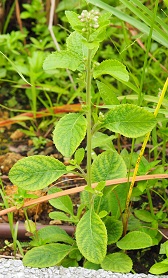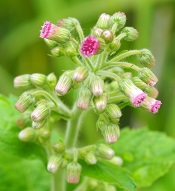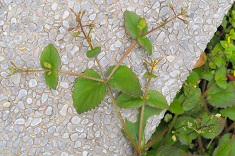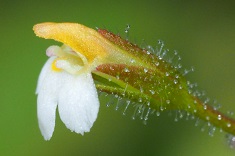| Home | Nature Weekly Index |
11 October 2020 | Two New Plants | Blumea axillaris | Lindernia viscosa |


 Finding a new plants in urban area in Singapore happened occasionally but it would be a rare event. On 26
September, I found not just one but two of them in a small roof-top garden near where I stay. The garden,
located on the roof-top of a multi-storey car park, in a newly build up area was probably about 2 years old. I
had not visited the garden until that day. It was a cloudy and rather windy day.
Finding a new plants in urban area in Singapore happened occasionally but it would be a rare event. On 26
September, I found not just one but two of them in a small roof-top garden near where I stay. The garden,
located on the roof-top of a multi-storey car park, in a newly build up area was probably about 2 years old. I
had not visited the garden until that day. It was a cloudy and rather windy day.
The first plant, Blumea axillaris is a member of the sunflower family (Asteraceae). At first, I thought that it was Blumea lacera but the leaves and flowers did not match well. Blumea axillaris was not listed in the 2019 flora checklist of Singapore. The iNaturalist website viewed on 9 October reported 26 observations, mostly from Hong Kong and Taiwan but none from Singapore. According to Plants of the World Online website, this plant is native to a long list of countries. The two closest to Singapore being Philippines and Thailand.
Besides residing on the roof-top garden, the plant had already spread to the surrounding area, a few blocks away from the car park. The occasional windy weather was likely the catalyst of its spread. Nevertheless, this plant is unlikely to be widespread as it will not survive the frequent grass-cutting exercise.
While Blumea lacera was easily visible among the greens due to its height and floret bundles, the second new plant, Lindernia viscosa (Sticky Lindernia) being a small low-lying creeper was much harder to locate. At the first glance, it looked very similar to Legazpia polygonoides (Malayan Eyebright), especially the flowers. The biggest distinction between them was the hairy creeping stem of Lindernia viscosa compared to the almost hairless stem of Legazpia polygonoides. I was uncertain whether it was a new plant until I compared the pictures taken back home with known species in my website. It was listed in the 2019 flora checklist of Singapore. The iNaturalist website viewed on 9 October reported 5 observations, 3 from Indonesia and 2 from India. I managed to find a picture of this plant taken in Singapore from a Facebook post by Our Little Flowers dated 31 May 2018.




Update: 9 July 2023
The accepted botanical name of Sticky Lindernia was changed to Yamazakia viscosa according to the iNaturalist and Plants of the World Online (POWO) websites. In iNaturalist, the observations had increased to 23 when viewed on 9 July 2023 and including one observation from Singapore on 25 March 2022.
Apparently, several of the plants in the family Linderniaceae had undergone changes to their accepted botanical names as well. Of the 7 species available in my website, name changed took place for 5 of them.
| Original Name | Current Name | Records in iNaturalist | iNaturalist Link | POWO Link |
| Legazpia polygonoides | Torenia polygonoides | 154 | Link | Link |
| Lindernia antipoda | Bonnaya antipoda | 654 | Link | Link |
| Lindernia crustacea | Torenia crustacea | 3602 | Link | Link |
| Lindernia diffusa | Vandellia diffusa | 75 | Link | Link |
| Lindernia rotundifolia | - | 383 | Link | Link |
| Lindernia viscosa | Yamazakia viscosa | 23 | Link | Link |
| Torenia fournieri | - | 1927 | Link | Link |
Except for Torenia fournieri which is a ornamental plant, the rest of them are wild herbaceous plants. Both Bonnaya antipoda and Lindernia rotundifolia are found in wetland area. The rest of the 4 are low-lying weedy plants.
As for Blumea axillaris, the worldwide observations had risen to 208 including 10 records from Singapore when viewed on 9 July 2023. The earlist record in the list from Singapore was sighted on 23 November 2020.